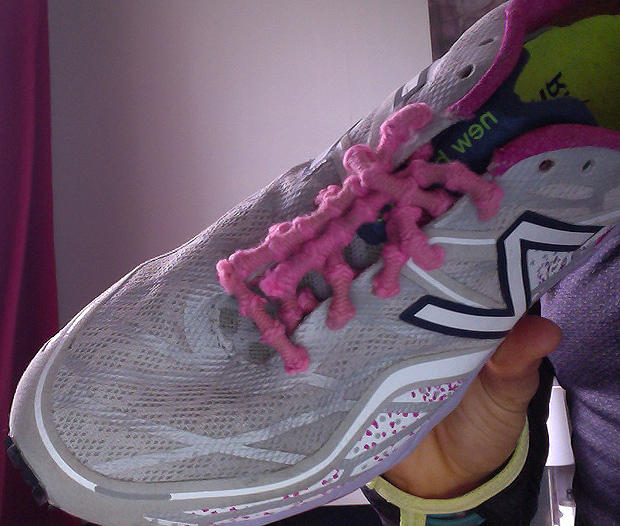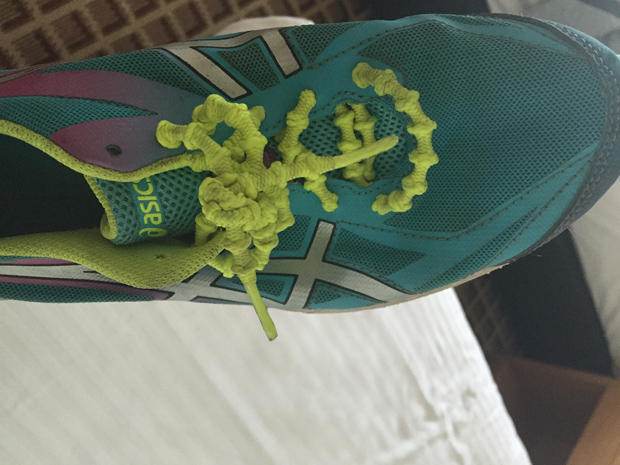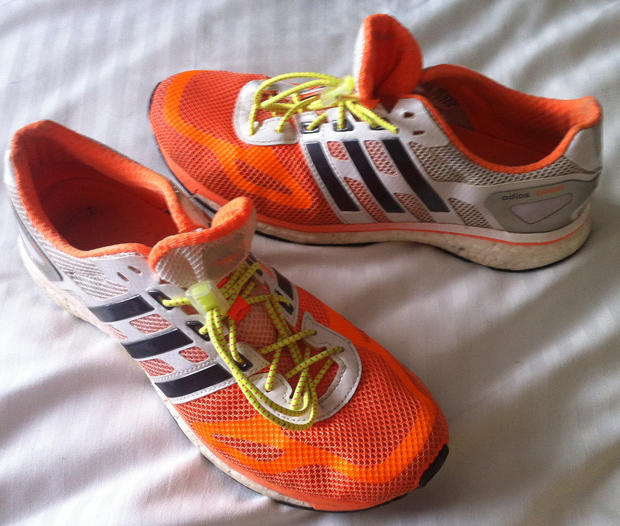Have you watched the ITU racing on television? These athletes have brought the transition to a ridiculous level. I'd like to see the world's fastest pure running women race Gwen Jorgensen in a 10k. Nobody has to swim or bike. Just, the race starts with each athlete rolling a bike into T2. Everybody has to perform that transition. Suddenly, just having to perform t2, I think the race gets a lot closer.
No self-respecting pure runner spends 5 seconds putting on his or her racing flats, yet ITU racers are forced to do it in less time than that. What amazes me is that they then run mid-29s or mid-32s, male and female, in their hastily donned footwear. Top Ironman racers are not much slower in transition.
I asked top ITU coach Jamie Turner (Gwen Jorgensen among others) what his racers use. I expected them all to be in the same lacing system, but, no. Here are a number of his athletes' shoes and systems.

Above are the very orderly shoes of Barbara Riveros. These are Xtenex laces and the unique feature of Xtenex is the elastic, expandable knot that, when pulled tight, straightens (the knot goes away). This allows the shoelace to move through the eyelets or holes when inserting them into the shoe. They stay put at all other times.
Below are Aaron Royle's new lacing system he's trying out. These are from Asics, and these replace the Xtenex laces he was using. For him, and a number of others, the Xtenex knots in the laces bother him. Xtenex seems to be a very popular lace of choice because it allows the user to custom design shoe tightness up and down the shoe through deciding how many knots span the distance between holes on either side of the eyestay. But if the knots bother you, no can do.

Below are the shoes of Amelie Kretz. Again, Xtenex.

Estibaliz Cabañes is another example of laces from Asics. Is the Asics lace different from the typical elastic laces with lock downs? I can't see the difference. You can find them from 2XU, Profile Design, Orca (Sebastian Kienle used Orca's in his win last year in Kona), and from others.

Below, Jake Birtwhistle is again using the laces from Asics.

Sarah-Anne Brault's shoes below have, as you see, Xtenex laces.

Tyler Mislawchuk is obviously wearing New Balance RevLites, but his laces are from another footwear company, Karrimore. They seem to be standard elastic laces with closures.

Here is a list of popular companies making lacing systems used by triathletes:
Yankz
Greeper
LockLaces
Xtenex
Speedlaces
BOA
Salomon
Greeper laces are popular among top Ironman triathletes. Greeper, and the BOA lacing system, differ from some of the others in that they don't use elastic laces. This is also the case with one version of Speedlaces. If you want your shoes to go on lightning fast, which is the case with ITU racers, it seems that elastic laces are a necessity.
But over the long haul, in a 70.3 or longer, it could be that the quality of the shoe's fit overrides that extra few seconds that elastic laces give you. Greepers do this. So do Speedlaces, which offer frictionless attachments that affix to the eyelets that allow you to pull the entire shoelace equally tight throughout the shoe.
So does the BOA system.
LockLaces are a slightly more polished version of the typical elastic lace with stopper. Nathan (the hydration company) sells this under its own name and I've seen the Nathan version of LockLaces priced more inexpensively.
I list Salomon here not because it's popular with triathletes, but its lacing system is very popular with ultra trail runners. BOA, Salomon and some other systems seem to me the best for XTERRA and other races where you don't want the foot moving around in the shoe, such movement perhaps afforded by elastic laces.
Finally, a big thank you to Jamie Turner's squad for taking the time to give Slowtwitchers an insight into your own equipment choices.


